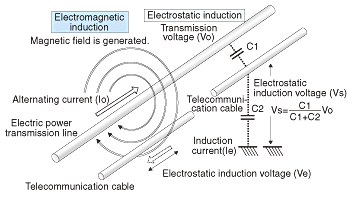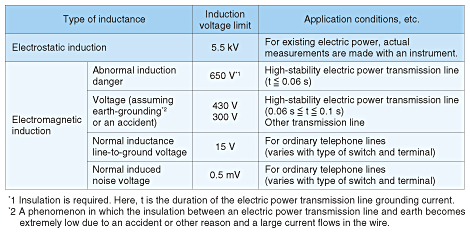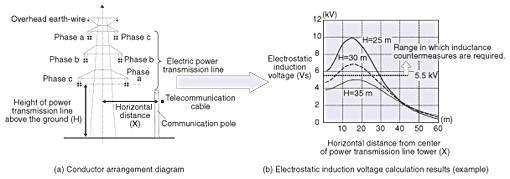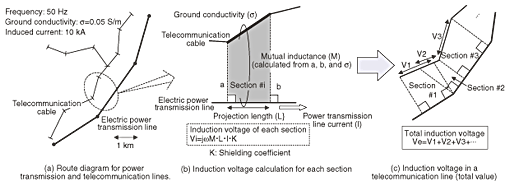 |
|||
|
|
|||
|
Special Feature on Technical Solutions to Real-world Problems Vol. 5, No. 8, pp. 11–14, Aug. 2007. https://doi.org/10.53829/ntr200708sf3 Calculation Method to Estimate Electrostatic and Electromagnetic Induction in the Design of Telecommunication FacilitiesAbstractThis article describes the characteristics of the electrostatic induction and electromagnetic induction generated by high-voltage transmission lines or alternating current railroad tracks that affect communication lines. The mechanisms of these induction phenomena are also described. Then, a specific calculation method for estimating the induced voltage is presented. This method can provide design guidelines for the new construction or relocation of communication facilities and electric power facilities.
1. Importance of induction countermeasuresWhen a telecommunication cable is installed near very high-voltage transmission lines or railroad tracks electrified with alternating current, voltage is induced within the wire of a metal cable or in the metallic tension members of an optical fiber cable by either electrostatic induction or electromagnetic induction. This induced voltage threatens the safety of cable maintenance workers and may also cause noise in telecommunication equipment or even lead to the malfunction of equipment. Therefore, calculations to estimate the induction voltage are performed on the basis of agreements between telecommunication carriers and electric power companies. They are performed before existing facilities are moved or expanded or new facilities are constructed. If the calculated induction voltage is above a certain limiting value, appropriate countermeasures against the induction voltage are considered during the design phase. 2. Induction mechanismsThe induction mechanism is broadly categorized into electrostatic or electromagnetic induction. The generation mechanisms are illustrated in Fig. 1.
Electrostatic induction is caused by a high voltage in an electric power transmission line or other such sources. Electrostatic capacitance C1 exists between the electric power transmission line and the telecommunication cable. Electrostatic capacitance C2 also exists between the telecommunication cable and earth. These electrostatic capacitances lead to the voltage dividing of the alternating current voltage Vo, and then electrostatic induction voltage Vs arises between the telecommunication cable and earth. Electromagnetic induction, on the other hand, is caused by the current flowing in the electric power transmission line or other such source. The alternating current in the electric power transmission line, Io, induces a time-varying magnetic field around the electric power transmission line. As the magnetic field gives rise to the induced current Ie that flows to prevent the magnetic field from varying in the electric power cable, the electromagnetic induction voltage Ve is also generated in the telecommunication cable. The types of induction voltage and their limits are presented in Table 1.
3. Actual induction estimation calculations and countermeasures3.1 Electrostatic inductionFigure 2 shows the conductor arrangement diagram of an electric transmission facility and an example of the calculated results of estimating the electrostatic induction. These calculations require various parameters including the nominal voltage, the positional relationship between the electric power transmission line and the overhead earth-wire, the mutual arrangement, and the thicknesses of the electric power transmission line, overhead earth-wire, and telecommunication cable. That information can, however, be acquired from the conductor arrangement diagram shown in Fig. 2(a). The electrostatic induction voltage Vs can be obtained by calculating all of the electrostatic capacitances between the conductors and the electric power transmission line potentials based on the principle shown in Fig. 1.
An example of the calculated electrostatic induction voltage is shown in Fig. 2(b). In this example, when the height of the electric power transmission line above the ground, H, is 25 m and the telecommunication line is less than 30 m from the center of the steel transmission line tower, the induction voltage exceeds the 5.5 kV limit shown in Table 1. Generally, the most effective way to reduce the electrostatic induction voltage is to ensure there is an adequate distance between the electric power transmission and telecommunication lines. To that end, the facilities design must either re-route the telecommunication line so that the induction voltage is not exceeded or install the telecommunication line underground. 3.2 Electromagnetic inductionAn example of the calculation procedure to estimate the electromagnetic induction voltage is shown in Fig. 3. First, a route diagram for the electric power transmission and telecommunication lines (Fig. 3(a)) is created. Second, the telecommunication line is divided into several sections that are projected onto the electric power transmission line (Fig. 3(b)). The mutual inductance M of a certain section is obtained from the separation distances a and b and ground conductivity σ. The induction voltage Vi generated in this section #i is proportional to this value of M as well as to the projection length L and the current of power transmission line I. Finally, the induction voltage generated in the telecommunication line, Ve, is obtained by calculating the sum of the induction voltages of all projected sections, Vi (Fig. 3(c)).
If the calculated electromagnetic induction voltage exceeds the limit shown in Table 1, it is necessary to consider a countermeasure in the facilities design, such as changing the route of the telecommunication cable, installing the telecommunication cable underground, shielding the telecommunication cable against induction, or using insulation. 4. ConclusionWhile the calculations to estimate the induction voltage are extremely important in the design of field facilities, their procedures are difficult and complex because they involve many parameters. The Technical Assistance and Support Center has developed a Web application to make it easier to perform the induction voltage calculations. We sometimes hold technical seminars to explain the calculations from the basic theory to the actual computation and try to improve the usability of the application by reflecting the opinions of workers in the field. |
|||











